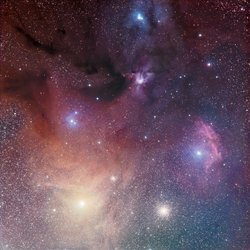One strip of the sky can teach us about the Universe
There are at least two areas in which the study of the interplay between physics and astronomy is especially important: the nature of dark matter and the nature of dark energy. Based on the strength of previous studies, scientists believe dark energy exists throughout space, making up some 73/;% of the total mass energy of the universe and influencing its rate of inflation. The Atacama Cosmology Telescope (ACT) is a six-metre telescope located in north Chile's Atacama Desert. Designed to conduct high-resolution, microwave-wavelength surveys of the sky, it is used for studying cosmic microwave background (CMB) radiation. This is the thermal radiation filling the observable universe and where space between stars and galaxies is completely dark. A telescope such as the ACT, however, is able to reveal a faint background glow that is not associated with any star, galaxy or other object. The 'Testing fundamental physics with the Atacama Cosmology Telescope' (ACT) project is working to develop techniques capable of analysing ACT data and mapping the results across some 200 square degrees of the CMB. Observations of a particular strip of sky, by back and forth scanning, are made at very high resolutions across 3 frequencies using a total of 3\;072 detectors. High ACT resolutions promise to yield information that will shed light on how galaxy clusters (the densest part of the universe's large-scale structure) make their mark on the CMB. Researchers are confident that the ACT will be able to detect hundreds of such clusters. Through results obtained, observed distortions of the CMB spectrum can be used to detect changes in density of the Universe — important for understanding more about the processes of expansion. ACT results have succeeded in measuring the statistical properties of the CMB temperature and discovering signals consistent with unresolved point sources. Such signals are crucial to testing inflationary models and for further investigations into the nature of dark energy. The EU-funded project has also measured certain features of the primary CMB, and presented initial results with specific galaxy cluster effects. Higher resolution and improved sensitivity CMB observations will allow new types of measurements to extend existing knowledge in the field of cosmology. Project partners expect that final maps will be useful for studying the primary as well as the secondary CMB.



